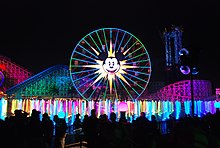User:Cecibudzyn/Animation
Education, propaganda and commercials[edit]
The clarity of animation makes it a powerful tool for instruction, while its total malleability also allows exaggeration that can be employed to convey strong emotions and to thwart reality. It has therefore been widely used for other purposes than mere entertainment.[1]
During World War II, animation was widely exploited for propaganda. Many American studios, including Warner Bros. and Disney, lent their talents and their cartoon characters to convey to the public certain war values. Some countries, including China, Japan and the United Kingdom, produced their first feature-length animation for their war efforts.[citation needed]
Mechanical[edit]
- Animatronics is the use of mechatronics to create machines that seem animate rather than robotic.
- Audio-Animatronics is a form of robotics animation, combined with 3-D animation, created by Walt Disney Imagineering for shows and attractions at Disney theme parks move and make noise (generally a recorded speech or song).[2] They are fixed to whatever supports them. They can sit and stand, and they cannot walk. An Audio-Animatron is different from an android-type robot in that it uses prerecorded movements and sounds, rather than responding to external stimuli. In 2009, Disney created an interactive version of the technology called Autonomatronics.[3]
- Linear Animation Generator is a form of animation by using static picture frames installed in a tunnel or a shaft. The animation illusion is created by putting the viewer in a linear motion, parallel to the installed picture frames.[4]
- Chuckimation is a type of animation created by the makers of the television series Action League Now! in which characters/props are thrown, or chucked from off camera or wiggled around to simulate talking by unseen hands.[5]
- The Magic Lantern used mechanical slides to project moving images. Christiaan Huygens was thought to have invented the Magic Lantern in the mid 1600’s.[6]
Other[edit]

- Hydrotechnics: a technique that includes lights, water, fire, fog, and lasers, with high-definition projections on mist screens.[7]
- Drawn-on-film animation: a technique where footage is produced by creating the images directly on film stock; for example, by Norman McLaren,[8] Len Lye and Stan Brakhage.
- Paint-on-glass animation: a technique for making animated films by manipulating slow drying oil paints on sheets of glass,[9] for example by Aleksandr Petrov.[10]
- Erasure animation: a technique using traditional 2D media, photographed over time as the artist manipulates the image. For example, William Kentridge is famous for his charcoal erasure films,[11] and Piotr Dumała for his auteur technique of animating scratches on plaster.[12]
- Pinscreen animation: makes use of a screen filled with movable pins that can be moved in or out by pressing an object onto the screen.[13] The screen is lit from the side so that the pins cast shadows. The technique has been used to create animated films with a range of textural effects difficult to achieve with traditional cel animation.[14]
- Sand animation: sand is moved around on a back- or front-lighted piece of glass to create each frame for an animated film.[15] This creates an interesting effect when animated because of the light contrast.[16]
- Flip book: a flip book (sometimes, especially in British English, called a flick book) is a book with a series of pictures that vary gradually from one page to the next, so that when the pages are turned rapidly, the pictures appear to animate by simulating motion or some other change.[17][18] Flip books are often illustrated books for children,[19] they also are geared towards adults and employ a series of photographs rather than drawings. Flip books are not always separate books, they appear as an added feature in ordinary books or magazines, often in the page corners.[17] Software packages and websites are also available that convert digital video files into custom-made flip books.[20]
- Character animation
- Multi-sketching
- Special effects animation
- 2.5D Animation: A mix of 2D and 3D animation elements that emphasize the illusion of depth utilizing the pseudo-3D effect.[21] During the 1970’s, the term “2.5D” started to gain recognition.[22] But its background comes from anime and manga during the 1920’s where theatrical stage productions were popular.[23] Stage adaptations of well-liked anime series featured live performances by voice actors called 2.5D.[24]
- ^ Lee, Tina (2019-05-02). "What Are Disney's 12 Principles of Animation? (With Examples)". Academy of Animated Art. Retrieved 2024-04-15.
- ^ Pilling 1997, p. 249.
- ^ O'Keefe 2014.
- ^ Parent 2007, pp. 22–23.
- ^ Kenyon 1998.
- ^ "About Magic Lanterns | Magic Lantern Society". www.magiclanternsociety.org. Retrieved 2024-04-24.
- ^ support@baianat.com. "Hydrotechnics animation". Baianat. Retrieved 2024-04-17.
- ^ Faber & Walters 2004, p. 1979.
- ^ Pilling 1997, p. 222.
- ^ Staff, Animation Obsessive (2023-05-19). "'The Cow': Paint in Motion". Animation Obsessive. Retrieved 2024-04-17.
- ^ Carbone 2010.
- ^ "Piotr Dumała". Culture.pl. Retrieved 2024-04-17.
- ^ Neupert 2011.
- ^ Pilling 1997, p. 204.
- ^ Brown 2003, p. 7.
- ^ Furniss 1998, pp. 30–33.
- ^ a b Laybourne 1998, pp. 22–24.
- ^ Solomon 1989, pp. 8–10.
- ^ Laybourne 1998, p. xiv.
- ^ White 2006, p. 203.
- ^ Digitalnomads (2023-10-24). "What is 2.5D animation?". Medium. Retrieved 2024-04-12.
- ^ "What is 2.5D? The Look Dominating Animation and Video Games". www.vfxapprentice.com. Retrieved 2024-04-17.
- ^ "What is 2.5-Dimensional (2.5D) Culture?". Google Arts & Culture. Retrieved 2024-04-17.
- ^ "What is 2.5D? The Look Dominating Animation and Video Games". www.vfxapprentice.com. Retrieved 2024-04-17.
